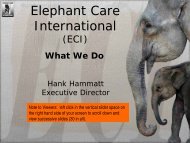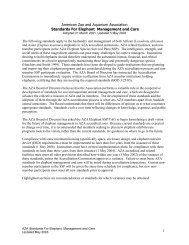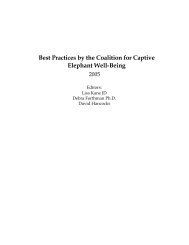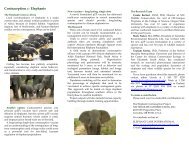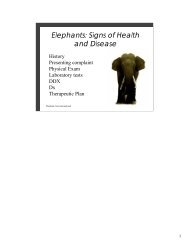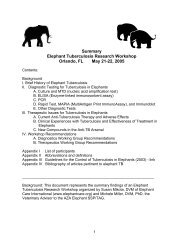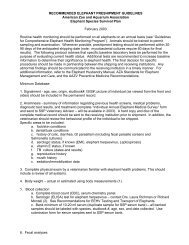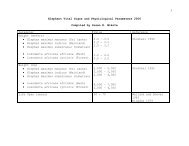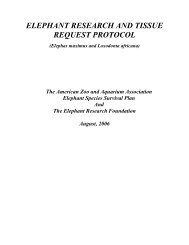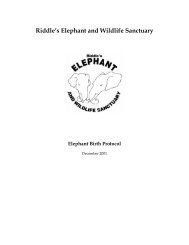Nepal Elephant TB Control and Mgt Action Plan.pdf - Elephant Care ...
Nepal Elephant TB Control and Mgt Action Plan.pdf - Elephant Care ...
Nepal Elephant TB Control and Mgt Action Plan.pdf - Elephant Care ...
- No tags were found...
Create successful ePaper yourself
Turn your PDF publications into a flip-book with our unique Google optimized e-Paper software.
<strong>Nepal</strong> <strong>Elephant</strong> Tuberculosis ulosis<strong>Control</strong> <strong>and</strong>Management agemen<strong>Action</strong> <strong>Plan</strong> (2011-2015)2015)1.3 Descripon of DiagnoscMethodsa. The <strong>Elephant</strong> <strong>TB</strong> Stat-Pak ® test is a bloodanbody test. A reacve test indicatesprobable <strong>TB</strong> infecon. Confirmaon withother tests is ideal - when possible <strong>and</strong> asdiscussed above. A non-reacve test indicatesno infecon <strong>and</strong> a <strong>TB</strong>-free status at the meof tesng. The <strong>Elephant</strong> <strong>TB</strong> Stat-Pak ® test isused as the st<strong>and</strong>ard roune <strong>TB</strong> screeningtest for elephants in <strong>Nepal</strong>. The test isadministered by the <strong>TB</strong> <strong>Plan</strong> veterinarian.b. The DPP Vet<strong>TB</strong> test is a blood anbody testused to confirm the <strong>Elephant</strong> <strong>TB</strong> Stat-Pak ® test.The <strong>Elephant</strong> <strong>TB</strong> Stat-Pak ® <strong>and</strong> DPP ® Vet<strong>TB</strong>tests have been shown to be early predictorsof infecon <strong>and</strong> may be reacve monthsto years in advance of detecon by culture(Greenwald et al. 2009). This provides theopportunity to treat elephants before theyshed <strong>and</strong> infect other elephants, humans, orwildlife.c. Culture is used to detect elephants that areacvely shedding <strong>TB</strong> organisms. Respiratorysamples obtained by collecng trunkdischarges are submi!ed to a laboratorythat is qualified to test for mycobacteria(this requires specific procedures). A posiveculture confirms that an elephant is acvelyinfected. Posive isolates should be tested toconfirm if the organisms were M. tuberculosisor M. bovis. Drug sensivity tesng (DST) foran-tuberculosis drugs (isoniazid, rifampin,<strong>and</strong> ethambutol) should be performed.Note that culture has inherent limitaons.Failure to isolate the organism does notrule out infecon. False-negave resultsmay occur 1) if the elephant is infected butorganisms are not shed on the day of samplecollecon or 2) contaminated trunk washsamples cause other organisms to overgrow.False-negave results allow <strong>TB</strong> disease toprogress <strong>and</strong> the infected elephant is a sourceto spread <strong>TB</strong> to other elephants, humans,or wildlife. Culture is expensive <strong>and</strong> manysamples may be needed to detect infecon. InSweden, of 189 trunk wash cultures collectedfrom 5 elephants confirmed <strong>TB</strong>-infected onpostmortem, only 7 samples were posive(Moller et al. 2005).Newer technologies that prove to be morereliable, sensive, or cost effecve fordetecng <strong>TB</strong> organisms in trunk wash or othersecreons will be incorporated into this planas they become available.d. PCR (polymerase chain reacon) is a type ofnucleic acid amplificaon test (NAAT). NAATsfacilitate the idenficaon of pathogens byamplifying <strong>and</strong> detecng specific nucleicacid sequences. PCR assays to detect <strong>TB</strong> inelephants in <strong>Nepal</strong> are under invesgaon bythe Center for Molecular Dynamics-<strong>Nepal</strong> (seeKay et al. 2011).e. LAMP (loop-mediated isothermalamplificaon) assay is a type of NAAT thatallows detecon of trace amounts of DNAunder isothermal condions. It has been usedto diagnose <strong>TB</strong> in humans in <strong>Nepal</strong> (P<strong>and</strong>ey etal. 2008) <strong>and</strong> is under invesgaon for use inelephants.1.4 Segregaon ProceduresSegregaon is an important management tool.Segregaon from wild elephants <strong>and</strong> otherwildlife (e.g. rhino) is considered a priority toprevent <strong>TB</strong> transmission to endangered wildlifepopulaons. Segregaon can also minimizetransmission to other capve elephants <strong>and</strong> tohumans. The goal of segregaon is to preventhealthy animals from coming into contact withrespiratory droplets or other secreons frominfected elephants.10



